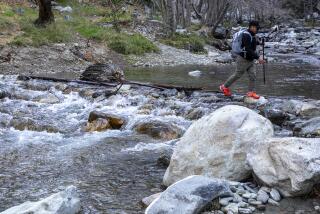A Link Between Times, Places
- Share via
I’m sitting astride my mountain bike out at the end of the Ventura Pier. The ride from Ojai was lovely, and now I’m being rewarded for my efforts by a cool west wind skimming across the water.
I’ve been waiting 11 years to cruise the 17-mile ribbon of asphalt that links my two favorite places in the world. Back in 1989, local voters turned thumbs down on a massive convention center at the Ventura County Fairgrounds, which resulted in $9 million being diverted to the transformation of an old railroad right of way into the best urban bike ride in Southern California.
Money well spent, I’d say.
Starting at the Ojai Racquet Club on Fox Street, the older portion of the bike path goes by in a blur. But at Devil’s Gulch in Oak View, the trail plunges down a very active earthquake fault. The earth’s constant motion has carved out a deep chasm that the route traverses via a dragon’s back barely 10 feet wide. It is here that one also catches a first glimpse of the Ventura River, now just a summer rivulet with a dry boulder field cutting a wide swath through the backyards of Oak View.
The trail levels out at the San Antonio Creek fair-weather crossing, where winter trail riders must hoist their bikes on strong shoulders and wade through the cold stream. But today there was just a mom in her minivan letting the kids frolic in the modest flow above the creek’s merger with the trunk of the river.
Past the crossing, the trail ducks behind the junk and jumble and old rusted cars in the lazy back acres of Rocky Flats, better known as Casitas Springs. All the while I tried to catch another glimpse of the river, invigorated now by the additional flow from the San Antonio. But it was shrouded by cottonwoods and eucalyptus growing thickly beside the levees that protect Casitas Springs and Foster Park from storms that have swollen the river to rise many feet above its rocky bed.
*
Soon the bike route passes the Foster Park bridge and merges into the new Ventura River Trail. The old bridge is a witness to Ventura’s pioneer era with its ornate Sespe sandstone parapets and faceless lion sculptures guarding the approach to E.P. Foster’s faded dream. A marble plaque dedicated by the Ventura County Board of Supervisors gives the date of 1908.
The river ride provides a chance to witness the dynamic changes taking place in the Ventura River basin, a region in transition from oil and agriculture to housing, high-tech communications and cottage industries. This is a ride through cultural and economic history, with oil field implements mounted as sculptures marking each kilometer of the route, their pedestals bearing cryptic messages such as: “Mark Time, to suspend progress and await developments.” This particular message is appropriate to the state of things along the river basin, where one senses the paradox of inevitable change in the midst of procrastination.
Even the earth beneath the river trail is in transition. This oil-rich terrain, with its deeply folded layers of strata, is arching upward by nearly an inch per year, forming the Ventura syncline. The Pacific tectonic plate is causing this accordion-like folding of the earth as it shoves its way shoreward. The rise of the syncline is clearly documented on the stretch of Highway 33 near the Canada Larga exit, where a portion of the roadbed must be repaved every few years to compensate for the expansion cracks.
The trail continues south along a narrow portion of land separating the old Petrochem oil refinery from the river. The sight of huge green storage tanks and rusted viscosity breakers now lying silent in the dust conjures memories of an early 1980s battle between environmentalists and the county. The issue was air pollution from a proposed expansion of the refinery, and it took the courts to decide in favor of the air. Petrochem has been closed ever since.
The next sighting along the route is the back lot of the former Santa Ventura movie studios, now as deserted as its neighbor. One can peek through the chain-link fence to catch a glimpse of a rustic street scene copied from some Latin American country. For an instant, I had the surreal sensation that I was witnessing the Ventura of some other era or a postmodern alternative in which Gen. Fremont loses the battle of San Pasqual.
Cycling down past the Kinko’s headquarters, I couldn’t help recall the big Vetco sign that once hung from the building. The transition out of oil and into high-tech communications came quickly to the corner of Stanley Avenue and the highway.
*
Another kilometer down the trail, the Westpark Community Center mural provides an opportunity for bike riders to enjoy public art at its finest. The sustainable-living motif on the north-facing wall is incredibly imaginative and beautiful.
Just around the corner from the park, with its concrete skateboard arena, the trail ends. But the ride itself goes on just by following Ventura Avenue to the intersection of West Main Street and proceeding past the Patagonia headquarters to the Ventura beach trail and another five miles of fine riding.
As I leave the pier and point my bike back toward Ojai I realize that the important things about Ventura really haven’t changed so much. In fact the addition of the Ventura River Bike Trail has helped make life that much better.
” Even the earth beneath the river trail is in transition, arching upward to form the Ventura syncline. “
More to Read
Sign up for The Wild
We’ll help you find the best places to hike, bike and run, as well as the perfect silent spots for meditation and yoga.
You may occasionally receive promotional content from the Los Angeles Times.






